New Brunswick, Canada
Flag
The flag of New Brunswick was proclaimed by the province's lieutenant governor in 1965. The design is based on the provincial shield of arms and features a gold lion on a red field and a boat. The lion symbolizes ties with the United Kingdom and the vessel signifies the importance of shipbuilding and seafaring to the province.
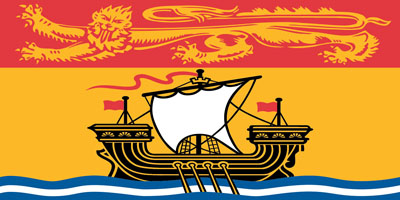
Other Provincial Symbols
- Floral Emblem: Purple Violet
- Tartan: New Brunswick Tartan
- Tree: Balsam Fir
- Bird: Black-capped Chickadee
- Official Soil: Holmesville Soil Series
- Fishing Fly: "Picture Province" Atlantic Salmon Fly
- Acadian Flag
Coat of Arms
The shield of New Brunswick's coat of arms was granted by Queen Victoria in 1868. The crest and supporters were granted and the motto confirmed by Queen Elizabeth II in 1984 to honour the 200th anniversary of New Brunswick's creation.
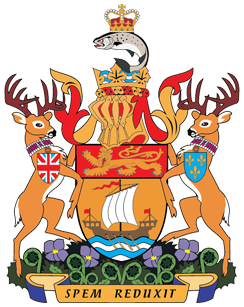
The upper third of the shield is red with a gold lion, symbolizing New Brunswick's ties to Britain. The lion is also found in the arms of the Duchy of Brunswick in Germany, the ancestral home of King George III. The lower part of the shield displays an ancient galley, most probably a reflection of the importance of shipbuilding and seafaring to New Brunswick in the 19th century. The galley is also based on the design of the province's original great seal, which featured a sailing ship on water.
The shield is supported by two white-tailed deer wearing collars of wampum. From one collar is suspended the Royal Union Flag, from the other the arms of Royalist France, to indicate the province's British and French background. Today, New Brunswick is Canada's only officially bilingual province.
The crest above the shield features an Atlantic salmon leaping from a coronet of gold maple leaves and bearing St. Edward's Crown on its back. The coat of arms' base is a grassy mound with fiddleheads and purple violets, the provincial floral emblem.

Origin of the Name
New Brunswick was named in 1784 to honour the reigning British monarch, King George III, who was also Duke of Brunswick.

History
The area now known as New Brunswick was originally inhabited by nations of the Algonquian linguistic group. The Mi'kmaq welcomed the French under Pierre de Monts and Samuel de Champlain when they first landed in New Brunswick in 1604. The relationship between the First Nations and the French was good from the start. The Mi'kmaq helped the French settlers, who became known as Acadians, adapt to the land. They also helped French troops launch raids on New England.
The Acadians were the first Europeans to settle in present-day New Brunswick. Until the Treaty of Utrecht in 1713, when France ceded the area to Great Britain, both Nova Scotia and New Brunswick were part of Acadia. However, over the years, France had all but ignored the Acadians, being much more concerned with New France and the increasing value of the fur trade there.
The Treaty of Utrecht created the British colony of Nova Scotia, which at that time included New Brunswick and Prince Edward Island. Nevertheless, Acadia continued for many years to be an area of conflict between the old world powers, and it was decades before the area was fully brought under British rule. After the British victory, many Acadians fled; others were expelled by the authorities in 1755.
In 1762, a trading community was established at the mouth of the St. John River by Massachusetts merchants. Before the peace of 1763, permanent British settlements were started by New Englanders at Chignecto and in the St. John River Valley. Settlers from Yorkshire, England, who came to Chignecto in the early 1770s, helped defeat an attempt from the rebellious colonies in 1776 to take Chignecto and its strategic Fort Cumberland/Beauséjour.
In 1783, thousands of Loyalist refugees from the American Revolution settled in the western part of Nova Scotia, far from the colony's administrative centre in Halifax. In response to Loyalist demands for their own colonial administration, the British government established the new colony of New Brunswick in 1784.
In 1864, New Brunswick was involved in discussions with the colonies of Nova Scotia, Prince Edward Island and Newfoundland to consider a Maritime union when the Province of Canada was issued an invitation to attend the conference in Charlottetown. The result, three years later, was the creation of the Dominion of Canada.
New Brunswick was among the first four provinces to form the Dominion of Canada at Confederation on July 1, 1867. Promises of increased prosperity, a railway linking New Brunswick to central Canada, and a desire to unite with other British colonies to form a strong country in the face of growing American influence, all encouraged New Brunswick to join Confederation.

Civic Flags
Fredericton, New Brunswick
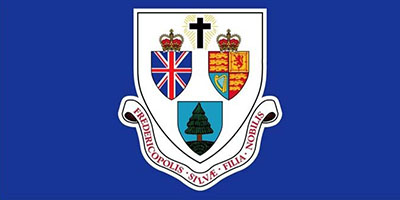

Drapeau
Le drapeau du Nouveau-Brunswick fut adopté en 1965 par proclamation du lieutenant gouverneur. Son dessin est tiré des armoiries de la province, qu'avait approuvées la reine Victoria en 1868. Les dimensions sont quatre de longueur sur deux et demie de largeur.
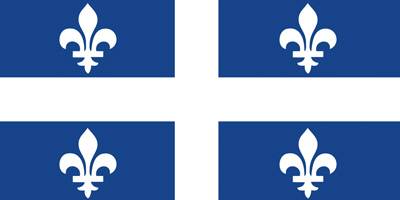
Armoiries
L'écu des armoiries du Nouveau-Brunswick fut accordé par décret de Sa Majesté la reine Victoria en 1868. En 1984, à l'occasion du bicentenaire du Nouveau-Brunswick, Sa Majesté la reine Elizabeth II octroya par décret le cimier et les supports et confirma la devise.
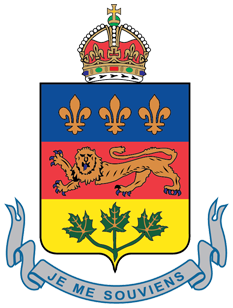
Le tiers supérieur de l'écu est orné d'un léopard d'or, symbole des liens qui unissent le Nouveau-Brunswick à la Grande-Bretagne. Le léopard figure également sur les armes du duché germanique de Brunswick, maison ancestrale du roi Georges III. La partie inférieure représente une galère antique, qui symbolise probablement l'importance de l'industrie de la construction navale et des pêcheries au Nouveau-Brunswick pendant le XIXe siècle. Elle rappelle le dessin du premier grand sceau de la province, qui représentait un voilier en mer.
L'écu est soutenu par deux cerfs de Virginie ceints de colliers de perles amérindiennes et portant en sautoir, l'un le drapeau royal de l'Union, et l'autre les armoiries de la France royaliste, pour souligner les origines britanniques et françaises de la province. À l'heure actuelle, le Nouveau-Brunswick est la seule province canadienne qui soit officiellement bilingue.
Le cimier représente un saumon de l'Atlantique portant sur le dos la couronne de Saint-Édouard et sautant hors d'une couronne de feuilles d'érable dorées. La base consiste en un tertre de têtes de violon et de violettes cucullées, l'emblème floral de la province.

Origines du nom
Le Nouveau-Brunswick a été ainsi nommé en 1784 en l'honneur du monarque britannique qui régnait à l'époque, le roi Georges III, qui était aussi duc de Brunswick.

Histoire
La région connue aujourd'hui sous le nom de Nouveau-Brunswick était à l'origine habitée par des nations de la famille linguistique algonquienne. Les Mi'Kmaq furent les premiers à accueillir les Français qui accompagnaient Samuel de Champlain et de Monts lorsqu'ils débarquèrent au Nouveau-Brunswick en 1604. Les Premières nations établirent dès le départ de bonnes relations avec les Français. Ils aidèrent ceux-ci, qui devinrent plus tard les Acadiens, à s'adapter à leur nouveau pays. Ils participèrent aussi aux attaques que menèrent les troupes françaises contre la Nouvelle-Angleterre.
Les Acadiens furent les premiers Européens à s'établir dans la région qu'occupe aujourd'hui le Nouveau-Brunswick. Jusqu'à la signature du Traité d'Utrecht en 1713, aux termes duquel les Français cédèrent le territoire aux Britanniques, la Nouvelle-Écosse et le Nouveau-Brunswick faisaient partie de l'Acadie. Avec le temps, toutefois, la France se désintéressa presque entièrement des Acadiens pour porter toute son attention sur la Nouvelle-France et l'importance croissante de la traite des fourrures.
Le Traité d'Utrecht créa la colonie britannique de la Nouvelle-Écosse, qui englobait à l'époque les territoires actuels du Nouveau-Brunswick et de l'Île-du-Prince-Édouard. L'Acadie, qui fut pendant de nombreuses années l'objet de conflits entre les puissances colonisatrices, fut entièrement soumise à l'autorité britannique après plusieurs décennies. Ce conflit força de nombreux Acadiens à s'enfuir, tandis que d'autres furent déportés en 1755.
En 1762, des marchands du Massachusetts érigèrent un poste de traite à l'embouchure de la rivière Saint-Jean. Avant la paix de 1763, les colons de la Nouvelle-Angleterre créèrent des colonies britanniques permanentes à Chignecto et dans la vallée de la rivière Saint-Jean. Des colons du Yorkshire s'établirent à Chignecto au début des années 1770. En 1776, ils aidèrent à défaire les colonies rebelles qui voulaient s'emparer de la ville et du Fort Cumberland–Beauséjour.
En 1783, la partie occidentale de la Nouvelle-Écosse devint le foyer de milliers de Loyalistes qui avaient fui la Révolution américaine. Cette région était isolée du centre administratif de la colonie, situé à Halifax. En 1784, à la demande des Loyalistes, le gouvernement britannique en fit la colonie du Nouveau-Brunswick.
En 1864, le Nouveau-Brunswick était en pourparlers avec les colonies de la Nouvelle-Écosse, de l'Île-du-Prince-Édouard et de Terre-Neuve en vue de réunir les régions maritimes, quand la Province du Canada fut invitée à participer à la conférence de Charlottetown. Il en découla la création du Dominion du Canada trois ans plus tard.
Le Nouveau-Brunswick fut l'une des quatre provinces fondatrices du Canada le 1er juillet 1867. Il espérait en retirer une plus grande prospérité, la construction d'un chemin de fer qui relierait son territoire au centre du Canada et le ralliement des colonies britanniques contre l'influence croissante des Américains.
















































